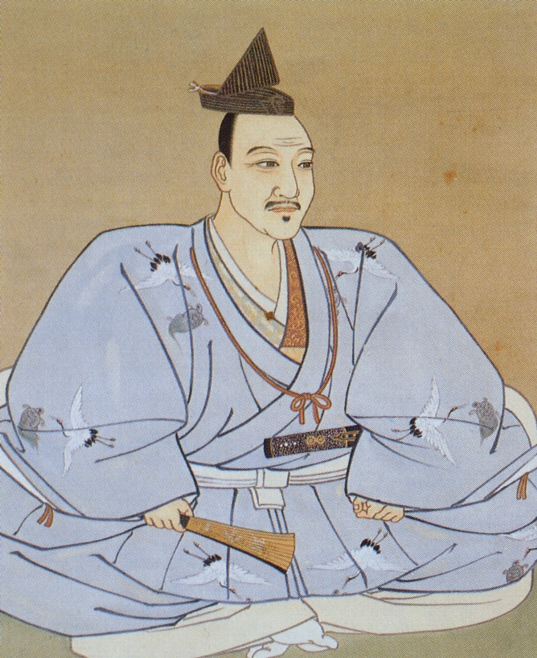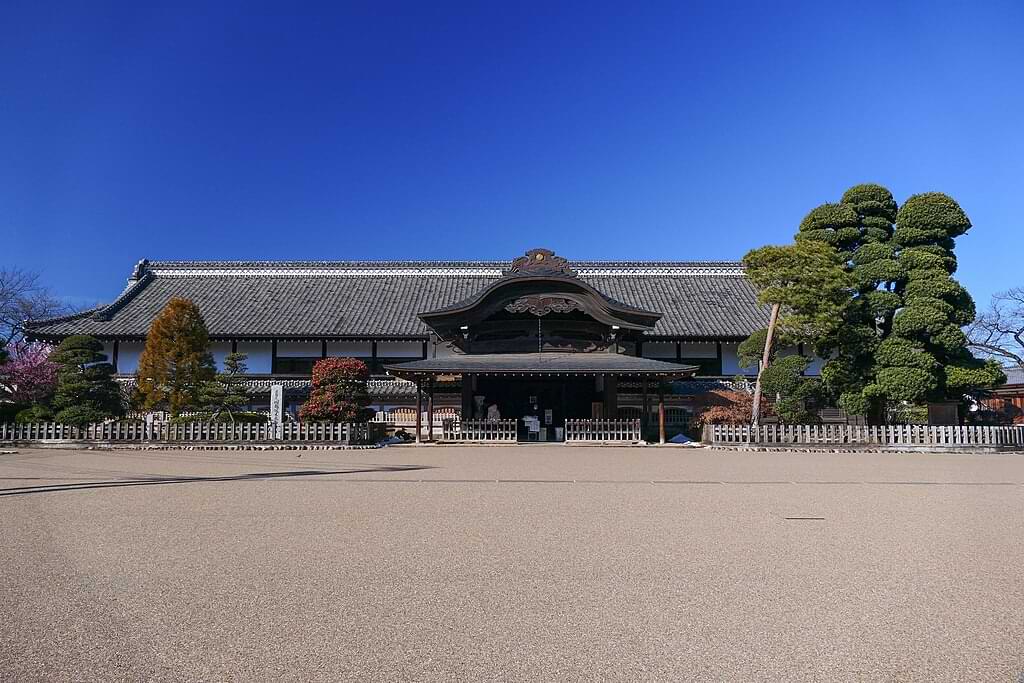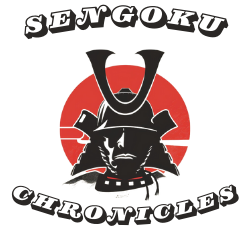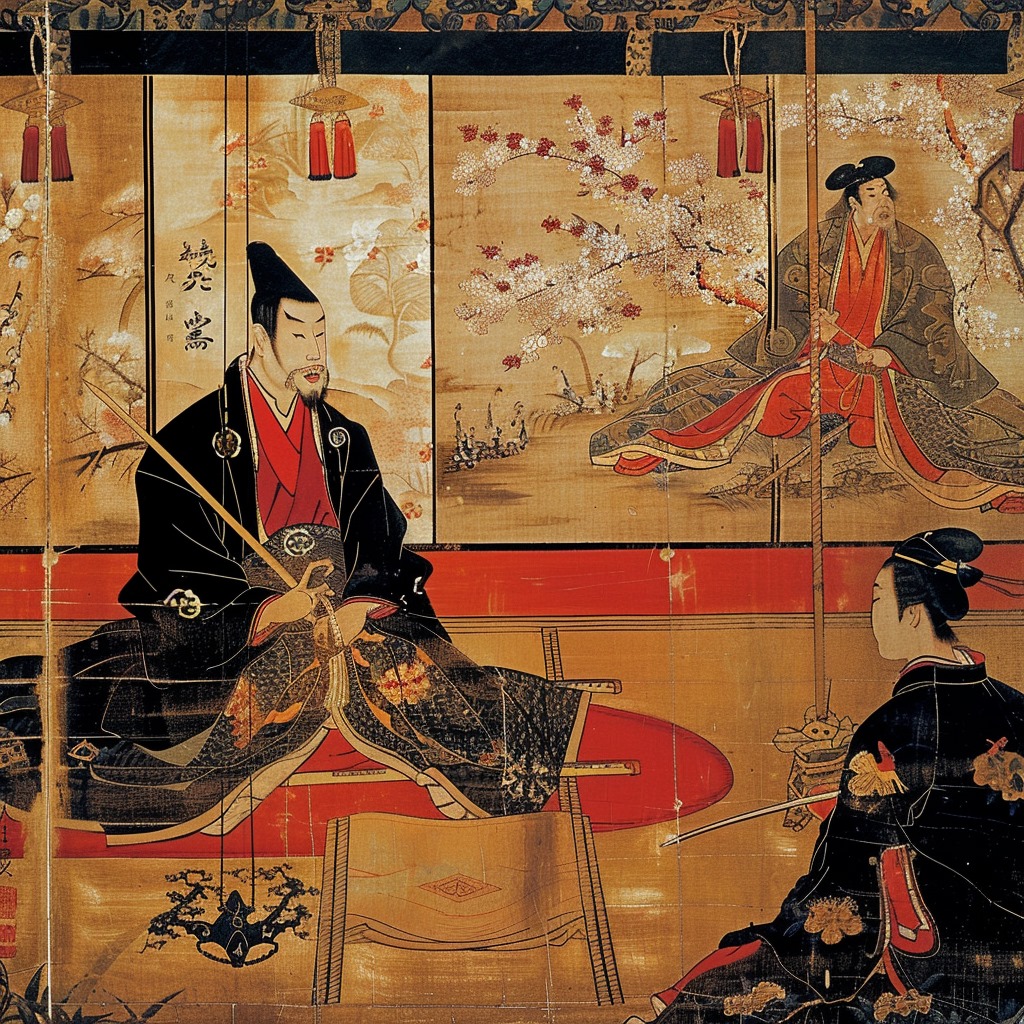Introduction
In the tapestry of Japan’s tumultuous past, the Sengoku period stands out as an era marked by relentless warfare, shifting alliances, and the rise of formidable leaders whose legacies continue to fascinate historians and cultural enthusiasts alike. Spanning the mid-15th to the late 16th century, this era, also known as the “Age of Warring States,” saw the fragmentation of Japan into numerous competing feudal domains. Amidst this backdrop of chaos and ambition, Hojo Ujiyasu emerged as a figure of significant prowess and strategic acumen, orchestrating the destiny of the Hojo clan and leaving an indelible mark on Japanese history.
Hojo Ujiyasu, the third head of the Late Hōjō clan, was not just a warrior but a visionary leader who navigated the complexities of military and political landscapes with remarkable dexterity. Born into the esteemed Hojo family, Ujiyasu’s inheritance was a realm fraught with challenges, yet ripe with opportunities for expansion and consolidation. Through a combination of martial might and diplomatic sagacity, Ujiyasu not only fortified his clan’s dominion but also fostered a period of relative stability and prosperity within his territories.
As we delve into the life and legacy of Hojo Ujiyasu, our journey will explore the multifaceted aspects of his leadership—from his early years and rise to power, through his most significant military campaigns, to his lasting impact on the socio-political fabric of the Sengoku period. Ujiyasu’s story is one of resilience, innovation, and the enduring quest for harmony amid the era’s relentless strife. Through this exploration, we aim to shed light on the enduring significance of Ujiyasu’s contributions and how his legacy continues to resonate in contemporary discussions of leadership, strategy, and cultural heritage.
Early Life of Hojo Ujiyasu: Foundations of a Feudal Leader
In the heart of the Sengoku period, a time marked by relentless warfare and political upheaval, Hojo Ujiyasu’s early years were shaped against a backdrop of strategic alliances and martial valor. Born in 1515 into the prestigious Hojo clan, Ujiyasu was thrust into a legacy of conflict and command from his very first breath. His lineage and upbringing played pivotal roles in sculpting him into a leader who would leave an indelible mark on Japan’s feudal history.
A Legacy of Leadership
As the progeny of Hojo Ujitsuna, Ujiyasu inherited a tradition of power and responsibility. The Late Hōjō clan, renowned for its martial prowess and strategic acumen, was at the forefront of the regional dynamics in the Kanto area. This environment was Ujiyasu’s cradle, teaching him the weight of his name and the expectations tied to it. From a young age, he was made aware of his destiny to lead, protect, and expand his family’s dominion.
Comprehensive Education for a Daimyo
Ujiyasu’s education was emblematic of a daimyo’s heir. It transcended the realms of mere physical combat to include studies in governance, economics, diplomacy, and the cultural arts. Such a broad curriculum was designed to prepare him for the complexities of leadership in a period characterized by incessant conflict and the need for shrewd political maneuvering. This blend of martial and scholarly training was crucial in developing a well-rounded leader, capable of wielding both the sword and the pen with equal proficiency.
The Warrior’s Path
Integral to Ujiyasu’s formative years was his initiation into the martial traditions of the samurai. Mastering the art of swordsmanship, archery, and horsemanship, Ujiyasu honed his skills on the battlefield and in strategy meetings. These experiences were not just about personal achievement but were essential in shaping a leader who could inspire loyalty and courage in his followers. The practical application of his martial training in skirmishes and battles during his youth was a critical aspect of his education, laying the groundwork for his future as a commander.
Influences and Inspirations
Under the guidance of his father, Ujitsuna, Ujiyasu absorbed the principles of leadership and warfare. Ujitsuna’s successful campaigns and the strategic alliances he forged highlighted the importance of adaptability, foresight, and the delicate balance between force and diplomacy. These early lessons in statecraft and military strategy from observing and assisting his father were invaluable, embedding in Ujiyasu a deep understanding of the art of governance and the nuances of power dynamics.
The early life of Hojo Ujiyasu was a testament to the rigorous preparation required for leadership during one of Japan’s most tumultuous eras. His heritage as a member of the Hojo clan set high expectations, while his education and martial training equipped him with the tools to meet those demands. Through these formative experiences, Ujiyasu was molded into a leader of both intellect and valor, ready to navigate the treacherous waters of the Sengoku period.
Rise to Power: Hojo Ujiyasu’s Ascendancy in the Sengoku Period

Hojo Ujiyasu’s journey from a promising heir to the formidable leader of the Hojo clan is a narrative of strategic brilliance, unwavering determination, and a deep understanding of the complexities of feudal Japan. Following the death of his father, Hojo Ujitsuna, in 1541, Ujiyasu inherited the mantle of leadership at a time when the Sengoku period was in full tumult, marked by incessant warfare and the ambitious rise of regional warlords.
Assuming Leadership Amidst Turmoil
Ujiyasu’s ascension came during a critical juncture for the Hojo clan, which was embroiled in conflicts on multiple fronts and faced threats from both established and emerging powers. The Kanto region, a strategic and contested area, was the stage upon which Ujiyasu would demonstrate his military and political acumen. His first challenge as the new head of the clan was to consolidate his authority internally and reaffirm the loyalties that bound the Hojo vassals and allies.
Navigating Early Conflicts
The early years of Ujiyasu’s reign were marked by a series of military engagements that tested his resolve and strategic thinking. Notable among these was the defense of the Hojo heartland against the growing power of the Uesugi clan, a formidable adversary that sought to expand its influence into the territories controlled by the Hojo. Through a combination of direct military confrontation and strategic fortification of key locations, Ujiyasu managed to thwart the Uesugi advances, securing the immediate borders of his domain.
Expanding Influence Through Diplomacy and Warfare
Ujiyasu’s tenure as the head of the Hojo clan saw a delicate balancing act between martial might and diplomatic negotiation. He engaged in a series of campaigns to expand his influence, negotiating alliances that would secure the clan’s position in the region. Through both force of arms and shrewd diplomacy, Ujiyasu managed to extend the Hojo’s control, navigating the complex web of alliances and enmities that characterized the Sengoku period.
The rise of Hojo Ujiyasu to power is a compelling chapter in the history of the Sengoku period, illustrating the multifaceted approach required to thrive in an era defined by constant conflict and shifting allegiances. His ability to combine military innovation with strategic diplomacy laid the foundation for the Hojo clan’s dominance in the Kanto region, marking Ujiyasu as one of the period’s most adept leaders.
Military Campaigns and Strategies
Hojo Ujiyasu’s tenure as the head of the Hojo clan during the turbulent Sengoku period was marked by a series of military campaigns that not only expanded the clan’s territories but also demonstrated his innovative strategies and leadership on the battlefield. These campaigns underscore Ujiyasu’s role as a master tactician and a strategist, adept at navigating the complexities of warfare in feudal Japan.
The Siege of Kawagoe Castle (1546)

The Siege of Kawagoe Castle in 1546 was a defining moment in Ujiyasu’s military career, showcasing his strategic brilliance and courage. Facing a vastly superior coalition force from the Uesugi, Takeda, and Imagawa clans, he executed a daring night attack, utilizing the element of surprise to devastating effect. This masterstroke not only preserved Kawagoe Castle and secured the Musashi Province for the Hojo clan but also significantly enhanced Ujiyasu’s reputation and the clan’s prestige, deterring future coalitions against them.
Defensive Innovations and Fortifications
Recognizing the importance of strong defensive positions in the era’s protracted warfare, Ujiyasu focused on enhancing the fortifications of his clan’s castles and territories. He pioneered the use of innovative defensive techniques, including the construction of stone walls and moats, which were revolutionary at the time. These fortifications made Hojo-held castles notoriously difficult to besiege, allowing Ujiyasu to secure his domain against external threats more effectively.
Diplomacy and Alliance Building
Ujiyasu’s strategic acumen was not limited to the battlefield; he was also a skilled diplomat who understood the value of alliances in the Sengoku period’s complex political landscape. By forging strategic marriages and alliances, Ujiyasu managed to neutralize potential threats and secure his clan’s position. His ability to navigate the intricate web of alliances and rivalries was instrumental in the Hojo clan’s survival and expansion.
Campaigns Against Rival Clans
Ujiyasu’s military campaigns extended beyond defensive actions, as he sought to expand the Hojo clan’s influence through strategic offensives against rival clans. His engagements with the Uesugi and Takeda clans, in particular, highlighted his tactical flexibility and his ability to adapt to the changing dynamics of warfare. Through a combination of direct military engagements and strategic territorial expansion, Ujiyasu managed to extend Hojo dominion, securing vital resources and strategic positions.
The Use of Naval Power
Understanding the strategic importance of controlling trade routes and coastal areas, Ujiyasu also focused on developing the Hojo clan’s naval capabilities. This allowed him to secure important maritime routes, enhancing trade and the movement of troops. The control of these routes not only bolstered the clan’s economic strength but also provided a strategic advantage in military campaigns.
Legacy as a Military Leader
Ujiyasu’s campaigns and strategies reflect his deep understanding of the multifaceted nature of warfare during the Sengoku period. His successes on the battlefield were not merely the result of martial prowess but were underpinned by a profound strategic vision that integrated military, diplomatic, and economic considerations. Ujiyasu’s legacy as a military leader is characterized by his innovative tactics, strategic foresight, and the ability to adapt to the ever-changing landscape of feudal Japan’s warfare.
Domestic Policies and Administration
Amidst the tumult and strife of the Sengoku period, Hojo Ujiyasu not only distinguished himself on the battlefield but also in the realm of governance and domestic policy. His administration of the Hojo territories was characterized by forward-thinking policies and reforms aimed at stabilizing and strengthening his domain from within. Ujiyasu’s approach to governance was multifaceted, focusing on economic development, social welfare, and cultural patronage, thereby ensuring the prosperity and loyalty of his people.
Agricultural Reforms and Land Management
Understanding that the strength of his clan depended on the economic stability and productivity of his territories, Ujiyasu implemented significant agricultural reforms. He encouraged the development of new agricultural techniques and the reclamation of land for cultivation, increasing the production of rice and other staple crops. This not only boosted the local economy but also ensured a stable food supply for his populace and army. Moreover, Ujiyasu’s policies on land management and distribution helped to alleviate peasant unrest, which was common in the era due to harsh feudal practices.
Trade Expansion and Economic Policies
Recognizing the importance of trade for economic prosperity, Ujiyasu worked to secure and expand trade routes within and beyond his domain. He fostered a conducive environment for commerce by building and improving roads and ports, and by offering protection to merchants. The Hojo clan’s control over strategic locations, such as the port of Uraga on the Tokyo Bay, allowed Ujiyasu to regulate trade effectively, thereby increasing the clan’s revenues and facilitating the import of valuable goods and technologies.
Infrastructure Development and Public Works
Ujiyasu’s tenure saw significant investments in infrastructure, including the construction and renovation of castles, roads, and irrigation systems. These projects not only bolstered the defense of his territories but also supported agricultural and economic activities. The enhancement of transportation networks improved communication and mobility, enabling more efficient administration and military responsiveness across the Hojo domains.
Social and Legal Reforms
To maintain order and ensure justice within his territories, Ujiyasu instituted a series of legal and social reforms. He established laws and regulations that sought to address the concerns of both samurai and peasants, aiming to create a more harmonious society. These measures included the codification of laws, the establishment of local governance structures, and the implementation of systems to address grievances and disputes. By promoting social stability, Ujiyasu fostered a sense of loyalty and duty among his subjects, crucial for maintaining authority during uncertain times.
Cultural Patronage and Buddhism
Beyond his military and administrative achievements, Ujiyasu is also remembered for his contributions to culture and religion. He was a patron of the arts and Buddhism, supporting temples, and commissioning works of art that enriched the cultural life of his domain. This patronage not only served to legitimize his rule but also contributed to the cultural and spiritual well-being of his people, enhancing the prestige of the Hojo clan.
Under Hojo Ujiyasu’s leadership, the domain witnessed significant advancements in governance, economic stability, and cultural development. His domestic policies and administrative reforms were pivotal in strengthening the foundations of his clan’s power, ensuring its prosperity amidst the ongoing conflicts of the Sengoku period. Through these endeavors, Ujiyasu demonstrated that effective leadership extends beyond military conquests to encompass the holistic development and welfare of one’s domain.
Legacy of Hojo Ujiyasu: The Enduring Influence of a Sengoku Strategist

The legacy of Hojo Ujiyasu extends far beyond the battlefield victories and territorial expansions that characterized his reign during the tumultuous Sengoku period. As a daimyo whose life and leadership were intricately woven into the fabric of feudal Japan, Ujiyasu’s contributions to military strategy, governance, and culture have left an indelible mark on Japanese history. His legacy is multifaceted, reflecting the complexity of the era he helped shape and the enduring lessons that can be drawn from his approach to leadership and conflict resolution.
A Military Innovator and Tactician
Ujiyasu is celebrated for his military ingenuity, particularly his successful defense strategies and the innovative siege tactics that became hallmarks of his military campaigns. The Siege of Kawagoe Castle remains one of the most studied and admired examples of Ujiyasu’s tactical brilliance, showcasing his ability to turn the tide against overwhelming odds. His contributions to the development of castle fortifications and the use of naval power further exemplify his forward-thinking approach to warfare. These innovations not only secured the Hojo clan’s dominance during his lifetime but also influenced Japanese military strategy for generations to come.
Governance and Domestic Policies
Beyond his military achievements, Ujiyasu’s legacy includes significant advancements in the governance and administration of his territories. His agricultural reforms, efforts to enhance trade, and investments in infrastructure development set the stage for economic stability and growth within the Hojo domains. These policies not only improved the lives of his subjects but also strengthened the clan’s economic base, contributing to its resilience in the face of external threats. Ujiyasu’s approach to governance, marked by a balance between martial prowess and economic development, serves as a model for effective leadership.
Cultural and Religious Contributions
Ujiyasu’s patronage of the arts and Buddhism contributed to the cultural enrichment of his domain, reflecting a broader understanding of power that encompassed spiritual and cultural dimensions. By supporting temples, artists, and cultural activities, Ujiyasu helped foster a sense of community and identity among his people, reinforcing the social cohesion necessary for sustaining his clan’s rule. These contributions to culture and religion underscore the holistic approach Ujiyasu took towards leadership, recognizing the importance of cultural prosperity alongside military and economic achievements.
An Enduring Figure in Japanese History
The legacy of Hojo Ujiyasu continues to captivate historians, scholars, and enthusiasts of Japanese history and culture. His life and leadership offer valuable insights into the complexities of the Sengoku period, a time of incessant warfare and dynamic social change. Ujiyasu’s ability to navigate this challenging landscape through a combination of military strategy, governance, and cultural patronage highlights his exceptional qualities as a leader. His contributions have been commemorated in literature, drama, and popular media, ensuring that his impact on Japanese history and culture remains alive for future generations to explore and appreciate.
Through his enduring legacy, Hojo Ujiyasu exemplifies the qualities of a visionary leader whose strategies, policies, and patronage contributed significantly to the shaping of feudal Japan. His life serves as a testament to the intricate blend of force, diplomacy, and culture that defined leadership during one of the most fascinating periods in Japanese history.
Conclusion
The legacy of Hojo Ujiyasu, woven into the tapestry of Japan’s tumultuous Sengoku period, offers profound insights into the complexities of leadership, warfare, and governance in feudal Japan. As a daimyo whose influence extended beyond the battlefield to the realms of administration, economy, and culture, Ujiyasu epitomizes the multifaceted nature of leadership during an era defined by constant conflict and shifting allegiances.
Ujiyasu’s innovative military strategies and tactics not only secured the Hojo clan’s dominance in the Kanto region but also contributed to the evolution of Japanese warfare. His successful defense of Kawagoe Castle and the implementation of advanced fortification techniques are testament to his tactical brilliance and foresight. These achievements highlight the importance of adaptability and innovation in overcoming challenges, lessons that remain relevant in military and strategic contexts today.
Beyond his martial accomplishments, Ujiyasu’s governance and domestic policies underscore the critical role of stable and effective administration in sustaining the prosperity and loyalty of a domain. Through agricultural reforms, infrastructure development, and economic policies, Ujiyasu laid the foundation for economic stability and growth within his territories. His approach to governance, characterized by a balance between strength and welfare, offers timeless lessons on the importance of holistic leadership that prioritizes the well-being of the populace alongside strategic and military objectives.
Ujiyasu’s patronage of the arts and Buddhism reflects a deep understanding of the cultural and spiritual dimensions of power. By fostering cultural enrichment and spiritual well-being, he strengthened the social cohesion and identity of his domain, illustrating the enduring value of culture and religion in shaping society and governance.
As we reflect on Hojo Ujiyasu’s legacy, it becomes evident that his contributions to Japanese history extend far beyond his lifetime, influencing military strategy, governance, and cultural development in ways that continue to resonate. His life and leadership embody the essence of the Sengoku period, offering valuable lessons on the complexity of human endeavors and the enduring impact of visionary leadership. In the modern world, where complexity and change are the only constants, the legacy of Hojo Ujiyasu serves as a beacon, guiding us through the challenges of leadership, governance, and cultural preservation.
Additional Resources
For those captivated by the life and achievements of Hojo Ujiyasu and wishing to delve deeper into the intricacies of his era, the following resources offer pathways to enrich your understanding of this formidable daimyo and the turbulent times he navigated. These resources range from scholarly works to cultural and historical sites, providing a comprehensive look at Ujiyasu’s impact on Japanese history and the Sengoku period.
Books and Academic Publications:
- “Samurai, Warfare and the State in Early Medieval Japan” by Karl F. Friday – This work provides an overview of the military and political landscape of Japan during the Sengoku period, with insights into the strategies and governance of feudal lords like Hojo Ujiyasu.
- “The Samurai Sourcebook” by Stephen Turnbull – Turnbull’s comprehensive guide offers detailed accounts of significant battles, figures, and events of the Sengoku period, including the exploits of Hojo Ujiyasu.
- “War in Japan: 1467-1615” by H. Paul Varley – Varley’s examination of warfare during Japan’s Age of Warring States offers context to Ujiyasu’s military campaigns and strategies.
Museums and Historical Sites:
- Hakone Checkpoint (Hakone Sekisho) – Once a vital checkpoint under the control of the Hojo clan, this restored site offers insights into the strategic significance of Hakone during Ujiyasu’s reign.
- Odawara Castle – The primary residence of the Hojo clan, Odawara Castle, has been meticulously restored and now houses a museum dedicated to the history of the Hojo clan and the Sengoku period.
- Kawagoe Castle – The site of Ujiyasu’s renowned victory, Kawagoe Castle, hosts exhibits related to the siege and the broader military history of the era.
Documentaries and Films:
- “Samurai: Behind the Blade” – This documentary explores the life of the samurai, including leaders like Hojo Ujiyasu, and offers insights into the martial traditions and strategies of the Sengoku period.
- Historical dramas (Taiga dramas) by NHK – Japan’s national broadcaster NHK has produced several epic historical drama series (Taiga dramas) that depict the lives of samurai leaders and the tumult of the Sengoku era. While these are fictionalized accounts, they often provide a compelling narrative basis for understanding the period’s complexities.
Online Resources:
- Nippon.com – An excellent source for articles on Japanese history and culture, including detailed pieces on the Sengoku period and notable figures like Hojo Ujiyasu.
- Samurai Archives – An online database and forum dedicated to the study of samurai history and Japanese culture, featuring discussions and articles on Hojo Ujiyasu and his contemporaries.
These resources offer a starting point for those interested in exploring the depths of Hojo Ujiyasu’s life and legacy. Whether through scholarly research, visits to historical sites, or engagement with cultural productions, there are numerous avenues to deepen your understanding of this pivotal figure in Japanese history.

